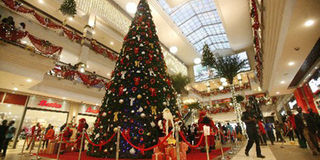How to choose, handle your Xmas tree

A Christmas Tree at Thika Road Mall along Thika Road in Nairobi after it was lit on December 1, 2013. PHOTO | FILE | NATION MEDIA GROUP
What you need to know:
- Trees should never be placed near windows that receive direct sunlight, heaters or fireplaces as these make them dry up prematurely.
- It is also important to note that Christmas trees can be fire hazards, especially if decorated with electrical lights. So before placing the lights, check them for faults.
- Do not use them if some parts of the cable on which the lights are strung are not properly insulated. Also, switch off the lights at nights or when nobody is home to prevent the leaves from losing moisture.
Christmas is just around the corner, and an important tradition among Christians during the festivities is to have decorated Christmas trees in their houses and places of worship.
Mr Maxwell Otieno, a landscape artist and owner of a horticultural firm in Kiambu County, says: “When people are looking for a Christmas tree, the primary consideration is often how long they will keep it in their houses. Thus it is advisable to ask for freshly cut trees, or cut one yourself.”
Choosing a healthy treeis also important, so you should avoid one with mature branches. But the tree’s branches shouldn’t be too feeble either, subce the decorations hung on them might fall off.
Also, avoid trees with browning leaves or a damaged bark as these tend to dry up quickly. Christmas trees look much smaller outdoors than they actually are. To get the size right, measure the height of the room as well as the width of the area where the tree will be placed.
“Before bringing a tree into your house, check it for spiders and insects to avoid Christmas scares,” suggests Mr Otieno.
And when you bring your tree home, place it in a bucket filled with rocks and some water to maintain its vitality slightly longer.
“Before mounting the tree, cut a few centimetres off its bottom part and immediately put it in water. This will greatly help in water absorption, ensuring that the tree lasts as long as possible,” Mr Otieno advises.
The gardener suggests that you spread a khanga on the floor in the area where the tree will be placed to make it easier to collect needles that fall from the tree. If they fall on the carpet, they can be hard to remove and thus pose a danger to toddlers and pets. A well-watered tree will loses fewer needles, so water it daily.
Trees should never be placed near windows that receive direct sunlight, heaters or fireplaces as these make them dry up prematurely.
It is also important to note that Christmas trees can be fire hazards, especially if decorated with electrical lights. So before placing the lights, check them for faults. Do not use them if some parts of the cable on which the lights are strung are not properly insulated. Also, switch off the lights at nights or when nobody is home to prevent the leaves from losing moisture.
“One should remember that a well-watered tree is less dry and hence less combustible,” notes Mr Otieno.
If you have pets and children, make sure that they cannot get to the tree as they can easily knock it over and cause serious accidents.
After the festivities you cut the tree into small pieces and put them in the garden where they will decompose into manure. For the environmentally conscience who might feel guilty about cutting up a tree and throwing it away after a few days, there’s the option of buying live trees, which can be replanted in one’s backyard after Christmas. However, they are more expensive and heavier because they come complete with roots and their soil.




